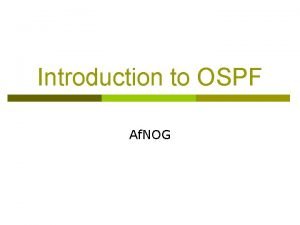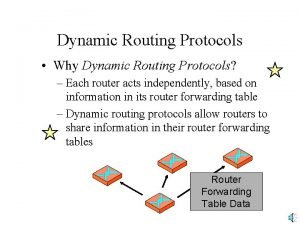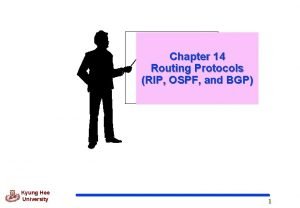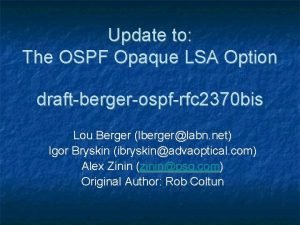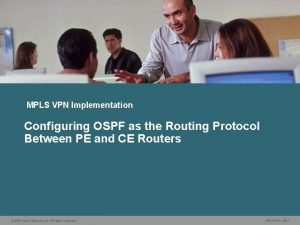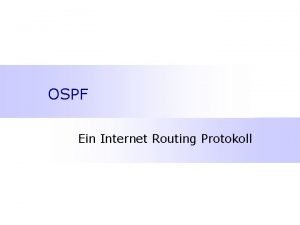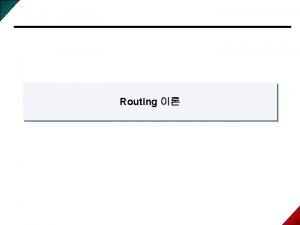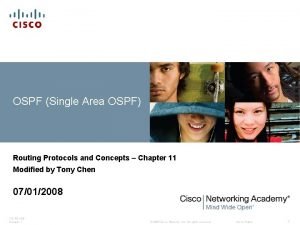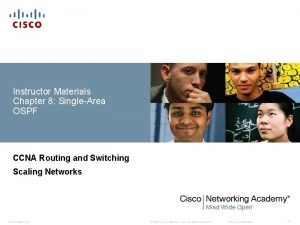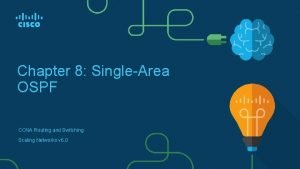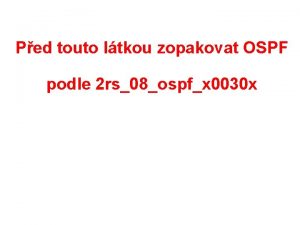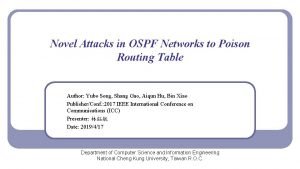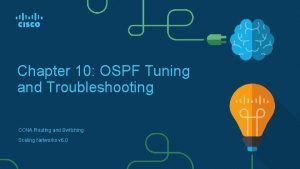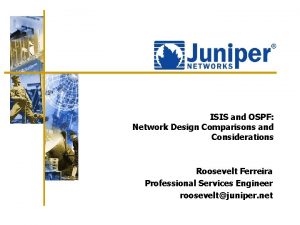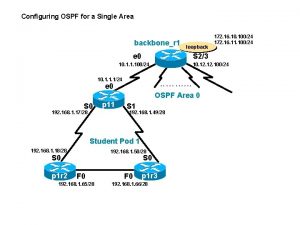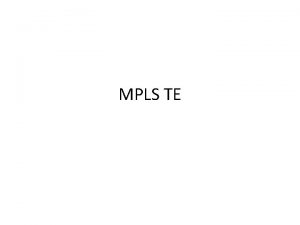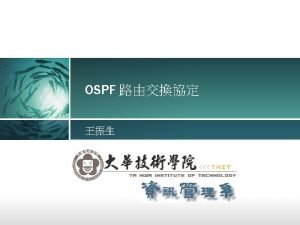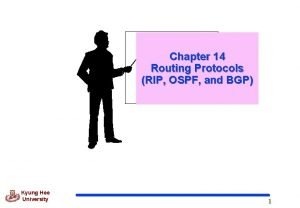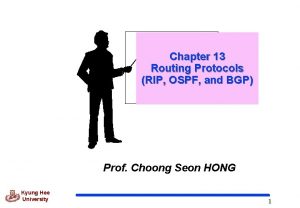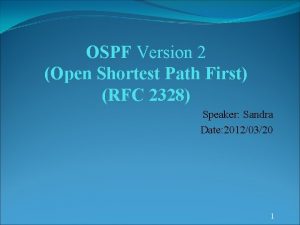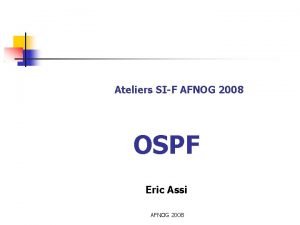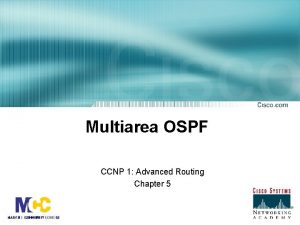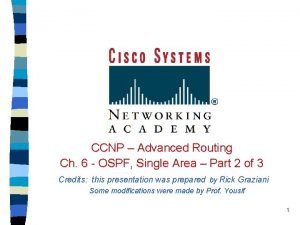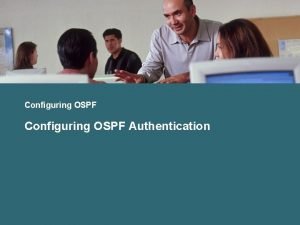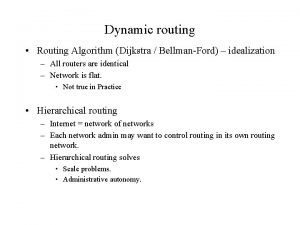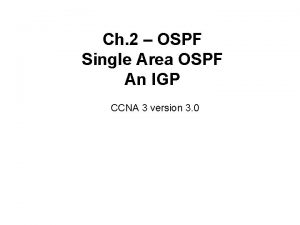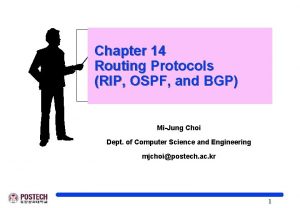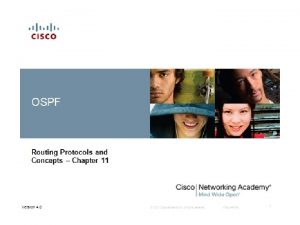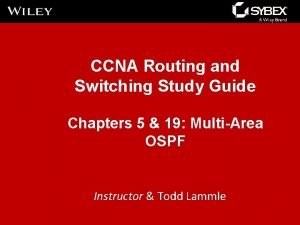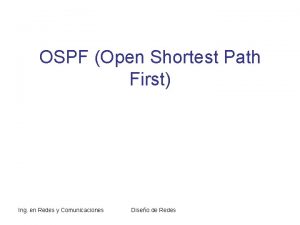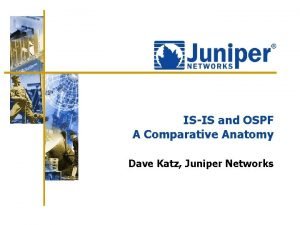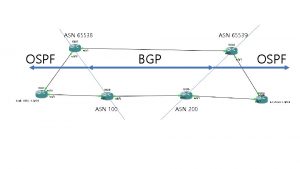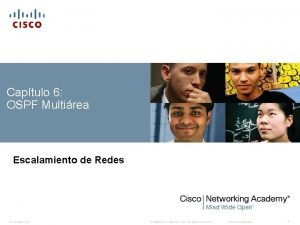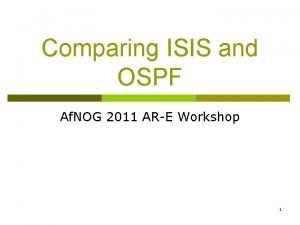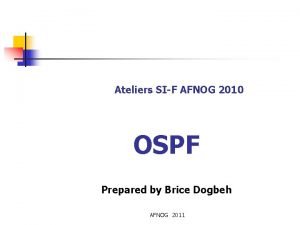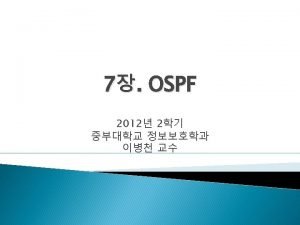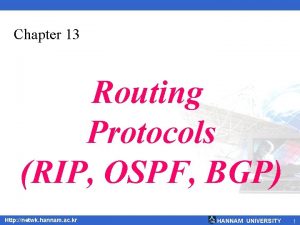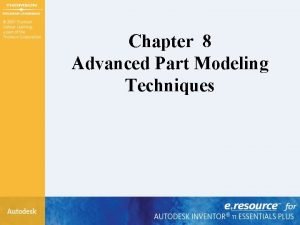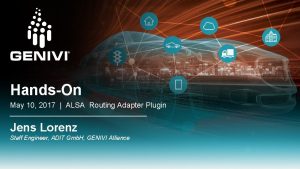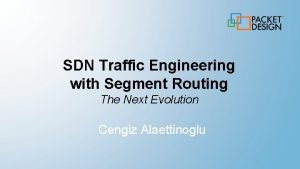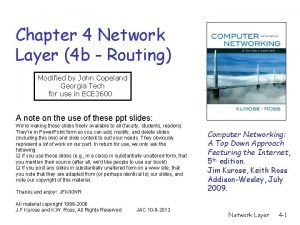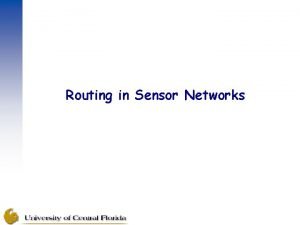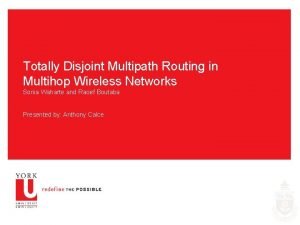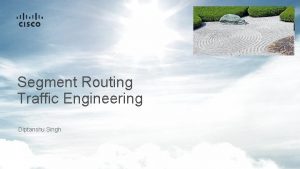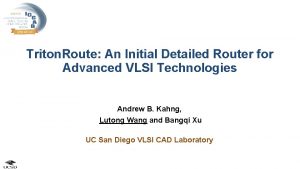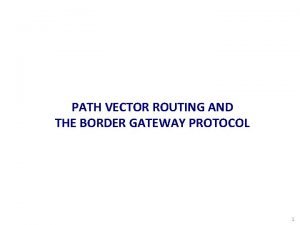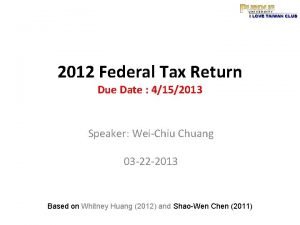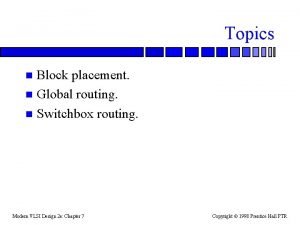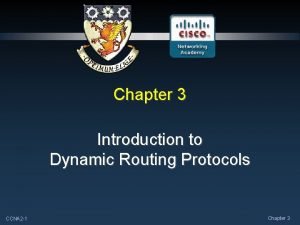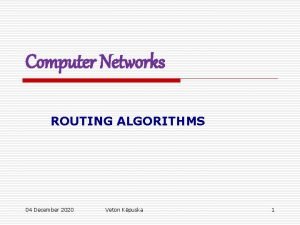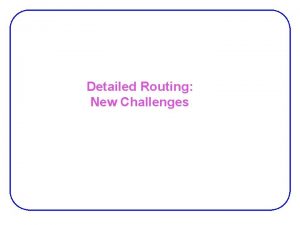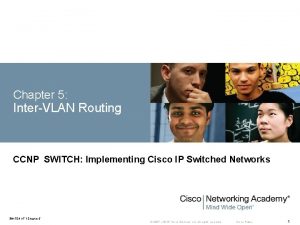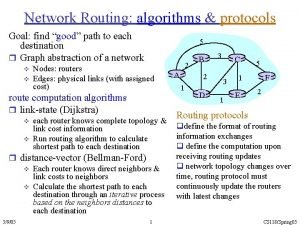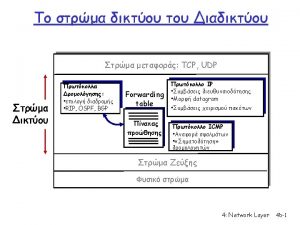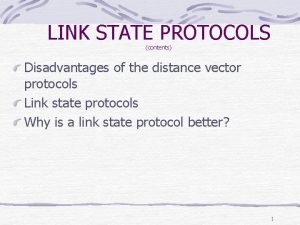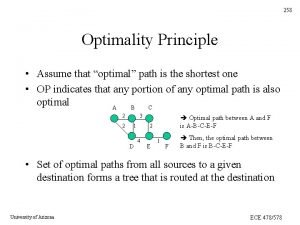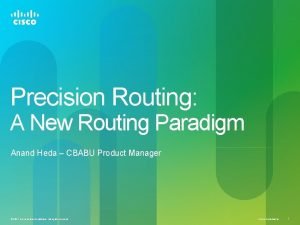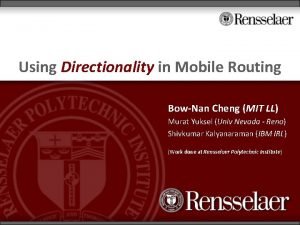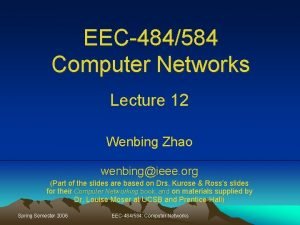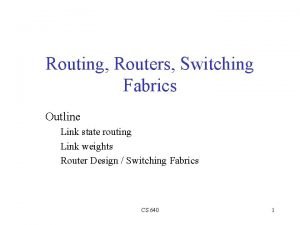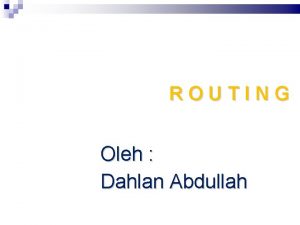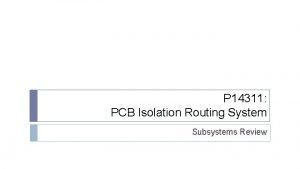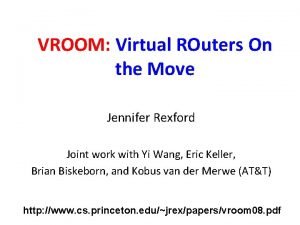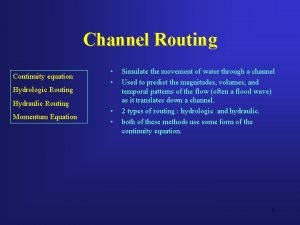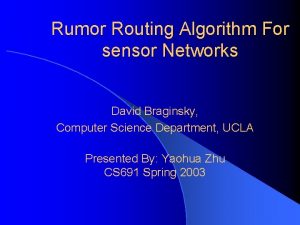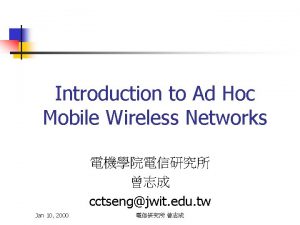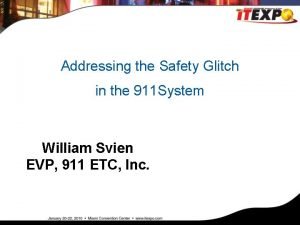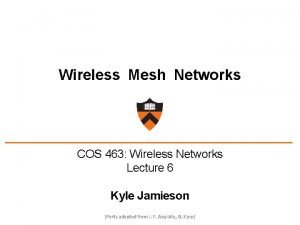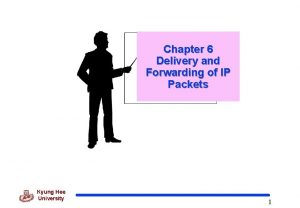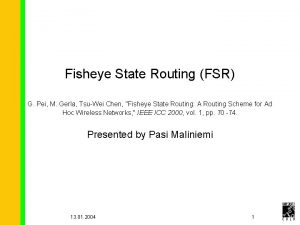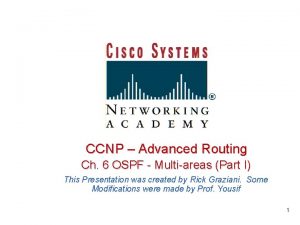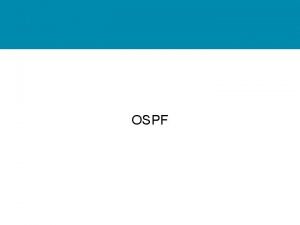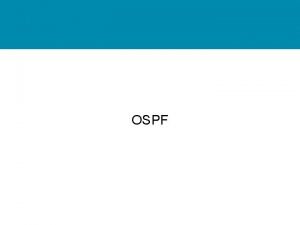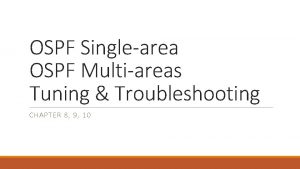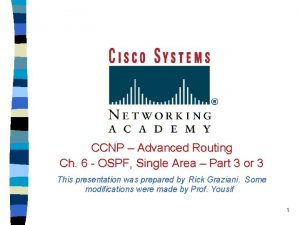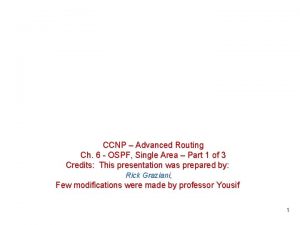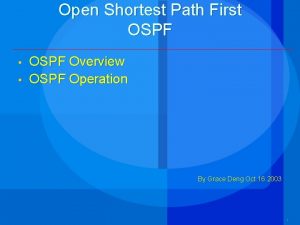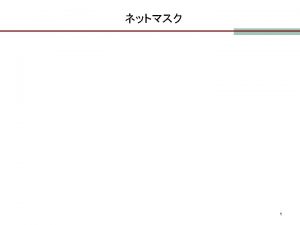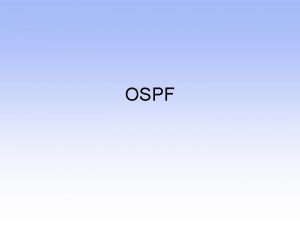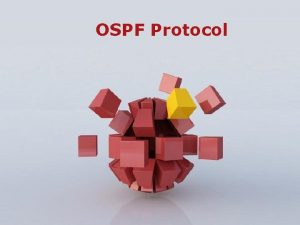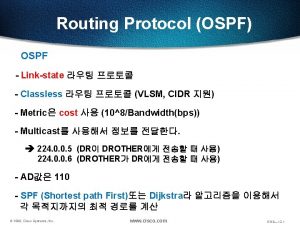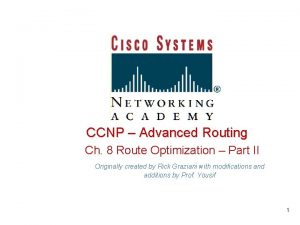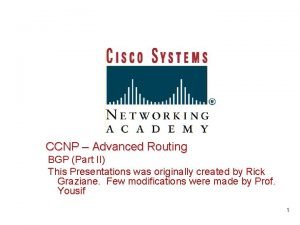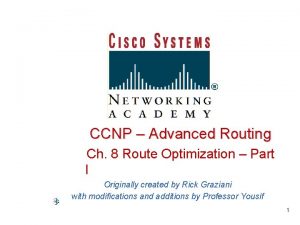CCNP Advanced Routing Ch 6 OSPF Multiareas Part
























































![Redistributing External Routes router ospf 1 redistribute routing-protocol metric-type [1|2] n metric-type 1 - Redistributing External Routes router ospf 1 redistribute routing-protocol metric-type [1|2] n metric-type 1 -](https://slidetodoc.com/presentation_image_h2/ad1ce244a063955e48b76f1e08f3c95b/image-57.jpg)

































- Slides: 90

CCNP – Advanced Routing Ch. 6 OSPF - Multi-areas (Part II) This presentation was created by Rick Graziani. Some modifications were made by Prof. Yousif 1

Quick Review n n Areas LSAs Stub Area Totally Stubby Area 2

Area Types n Standard or Normal Areas – Backbone – Non-Backbone n Stub – Stub Area – Totally Stubby Area (TSA) – Not-so-stubby-area (NSSA) 3

Area Types 4

LSA-1 - Router LSA 5

Multi Area OSPF LSA 1’s being sent within Area 0 LSA 1 Normal Areas LSA 1 6

LSA 1’s being sent within other areas Multi Area OSPF Normal Areas LSA 1 7

Multi Area OSPF Normal Areas LSA 1 Originated LSA 1’s are flooded out other interfaces within the same area. LSA 1 flooded 8

LSA-2 - Network LSA 9

Multi Area OSPF No LSA 2’s for ABR-1 in Area 51, or for Internal because no other routers on multiaccess segment. Normal Areas LSA 2 DR LSA 2 flooded DR 10

LSA-3 - Summary LSA 11

Multi Area OSPF LSA 1’s are sent as LSA 3’s into other areas by the ABRs. LSA 1 LSA 3 Normal Areas LSA 1 LSA 3 12

Multi Area OSPF LSA 1’s are sent as LSA 3’s into other areas by the ABRs. LSA 3 Normal Areas LSA 3 LSA 1 LSA 3 13

LSA-4 – ASBR Summary LSA 14

Normal Areas LSA 5’s flooded LSA 4 Area 1 15

LSA-5 - External LSA 16

ASBR router ospf 1 redistribute static network 172. 16. 1. 0 0. 0. 0. 255 area 0 ip route 11. 0. 0. 0 255. 0. 0. 0 Null 0 ip route 12. 0. 0. 0 255. 0. 0. 0 Null 0 ip route 13. 0. 0. 0 255. 0. 0. 0 Null 0 Normal Areas LSA 5’s flooded LSA 5 LSA 5 17

Stub Area 18

LSA 3 LSA 4 LSA 5 LSA 3 Blocked X Stub Area LSA 4 X Blocked Default route to ABR injected 19

Totally Stubby Area 20

LSA 3 LSA 4 LSA 5 LSA 3 Blocked XX Totally Stubby Area LSA 4 X Blocked Default route to ABR injected Area 1 21

NSSA Example 22

NSSA n n n n Relatively new, standards based OSPF enhancement, RFC 1587. NSSA allows an area to remain a stub area, but carry external routing information (Type 7 LSAs) from its stubby end back towards the OSPF backbone. ASBR in NSSA injects external routing information into the backbone and the NSSA area, but rejects external routing information coming from the ABR. The ABR does not inject a default route into the NSSA. – This is true for a NSSA Stub, but a default route is injected for a NSSA Totally Stubby area. Note: RFC 1587, “A default route must not be injected into the NSSA as a summary (type-3) LSA as in the stub area case. ” What? ? ? Following scenario is only example of how NSSA works. For the purposes of learning about NSSAs, don’t get hung up on the why’s and what if’s. 23

Default route via RTG NSSA Stub Area n n n Area 2 would like to be a stub network. RTH only supports RIP, so RTG will run RIP and redistribute those routes in OSPF. Unfortunately, this makes the area 2 router, RTG, an ASBR and therefore area 2 can no longer be a stub area. RTH does not need to learn routes from OSPF, a default route to RTG is all it needs. But all OSPF routers must know about the networks attached to the RIP router, RTH, to route packets to them. 24

Default route via RTG LSA 7 LSA 5 LSA 7 LSA 7 s Blocked NSSA Stub Area (cont. ) n n NSSA allow external routes to be advertised into the OSPF AS while retaining the characteristics of a stub area to the rest of the OSPF AS. ASBR RTG will originate Type-7 LSAs to advertise the external destinations. These LSA 7 s are flooded through the NSSA but are blocked by the NSSA ABR. The NSSA ABR translates LSA 7 s into LSA 5 s and flood other areas. 25

LSA Types (con’t) Type 7 LSA NSSA External Link Entry n Originated by an ASBR connected to an NSSA. n Type 7 messages can be flooded throughout NSSAs and translated into LSA Type 5 messages by ABRs. n Routes learned via Type-7 LSAs are denoted by either a default “N 1” or an “N 2” in the routing table. (Relative to E 1 and E 2). 26

NSSA Generic Default route via RTG LSA 7 LSA 5 LSA 7 LSA 7 s Blocked Configuring NSSA Stub Area Configured for all routers in Area 2: router ospf 1 network 172. 16. 2. 0 0. 0. 0. 255 area 2 nssa 27

NSSA Stub and NSSA Totally Stubby n There are two flavors in NSSA: – stub – totally stubby n Area 2 routers may or may not receive Inter-area routes from RTA, depending upon NSSA configuration n NSSA areas have take on the same characteristics as stub and totally stubby areas, along with the characteristics of NSSA areas. NSSA stub areas: n NSSAs that block type 4 and 5, but allow type 3. n To make a stub area into an NSSA, use the following command under the OSPF configuration. n This command must be configured on all routers in area 2. router ospf 1 area 2 nssa 28

NSSA Stub Areas Default route via RTG LSA 3 s RTH routes: N 1/N 2 LSA 4 s & LSA 5 s LSA 7 X 0. 0/0 LSA 7 X LSA 5 RTH routes: E 1/E 2 LSA 7 LSA 7 s Blocked NSSA Stub Area Routing Tables: n n n RTG: Area 2 routes, Area 0 routes (IA), RTH RIP routes – No 0. 0/0 (IA) route from RTB (ABR), despite documentation Area 2 Internal Routers: Area 2 routes, RTH routes (N 1/N 2), Area 0 routes (IA) – No 0. 0/0 (IA) route from RTB (ABR), despite documentation RTB: Area 2 routes, Area 0 routes, RTH routes (N 1/N 2), External routes if redistributed from RTA ASBR (E 1/E 2) RTA: Area 0 routes, Area 2 routes, RTH routes (E 1/E 2), External routes if redistributed from RTA (E 1/E 2) Note: Area 2 routers may or may not receive E 1/E 2 routes from RTA, depending 29 upon NSSA configuration (next).

NSSA Stub Areas Default route via RTG LSA 3 s RTH routes: N 1/N 2 LSA 4 s & LSA 5 s LSA 7 X 0. 0/0 LSA 7 X LSA 5 RTH routes: E 1/E 2 LSA 7 LSA 7 s Blocked Area 2 routers: router ospf 1 network 172. 16. 2. 0 0. 0. 0. 255 area 2 nssa 30

NSSA Totally Stubby Area n NSSA totally stub areas: Allow only summary default routes and filters everything else. n To configure an NSSA totally stub area, use the following command under the OSPF configuration on the NSSA ABR: router ospf 1 area 2 nssa no-summary Configure this command on NSSA ABRs only. n n n All other routers in area 2 (internal area 2 routers): router ospf 1 area 2 nssa After defining the NSSA totally stub area, area 2 has the following characteristics (in addition to the above NSSA characteristics): · No type 3 or 4 summary LSAs are allowed in area 2. This means no inter-area routes are allowed in area 2. · A default route is injected into the NSSA totally stub area as a type 3 summary LSA by the ABR. 31

NSSA Totally Stubby Areas Default route via RTG LSA 3 s X X 0. 0/0 RTH routes: N 1/N 2 LSA 4 s & LSA 5 s LSA 7 LSA 5 RTH routes: E 1/E 2 LSA 7 LSA 7 s Blocked RTB (ABR): router ospf 1 network 172. 16. 1. 0 0. 0. 0. 255 area 0 network 172. 16. 2. 0 0. 0. 0. 255 area 2. . . area 2 nssa no-summary Area 2 routers: router ospf 1 network 172. 16. 2. 0 0. 0. 0. 255 area 2 nssa 32

NSSA Totally Stubby Areas Default route via RTG LSA 3 s X X 0. 0/0 RTH routes: N 1/N 2 LSA 4 s & LSA 5 s LSA 7 LSA 5 RTH routes: E 1/E 2 LSA 7 LSA 7 s Blocked NSSA Totally Stubby Area Routing Tables: n n RTG: Area 2 routes, RTH RIP routes, 0. 0/0 (IA) route from RTB (ABR) – Totally Stubby: No Area 0 routes or external routes from RTA Area 2 Internal Routers: Area 2 routes, RTH routes (N 1/N 2), 0. 0/0 (IA) route from RTB (ABR) – Totally Stubby: No Area 0 routes or external routes from RTA RTB: Area 2 routes, Area 0 routes, RTH routes (N 1/N 2), External routes from RTA ASBR (E 1/E 2) if redistributed by ASBR 33 RTA: Area 0 routes, Area 2 routes, RTH routes (E 1/E 2), External routes (E 1/E 2)

More on NSSA n n Examples See NSSA document on my web site for more info. 34

Virtual Links 35

Virtual Links n All areas in an OSPF autonomous system must be physically connected to the backbone area (area 0). n In some cases where this is not possible, you can use a virtual link to connect to the backbone through a non-backbone area. n As mentioned above, you can also use virtual links to connect two parts of a partitioned backbone through a non-backbone area. n The area through which you configure the virtual link, known as a transit area, must have full routing information. n Must be configured between two ABRs. n The transit area cannot be a stub area. 36

Virtual Links n n A virtual link has the following two requirements: – It must be established between two routers that share a common area and are both ABRs. – One of these two routers must be connected to the backbone. Doyle, “should be used only as a temporary fix to an unavoidable topology problem. ” 37

Virtual Links The command to configure a virtual link is as follows: area <area-id> virtual-link <remote-router-id> RTA(config)#router ospf 1 RTA(config-router)#network 192. 168. 0. 0. 0. 255 area 51 RTA(config-router)#network 192. 168. 1. 0 0. 0. 0. 255 area 3 RTA(config-router)#area 3 virtual-link 10. 0. 0. 1. . . RTB(config)#router ospf 1 RTB(config-router)#network 192. 168. 1. 0 0. 0. 0. 255 area 3 RTB(config-router)#network 192. 168. 2. 0 0. 0. 0. 255 area 0 RTB(config-router)#area 3 virtual-link 10. 0. 0. 2 38

Virtual Links n OSPF allows for linking discontinuous parts of the backbone using a virtual link. n In some cases, different area 0 s need to be linked together. This can occur if, for example, a company is trying to merge two separate OSPF networks into one network with a common area 0. n In other instances, virtual-links are added for redundancy in case some router failure causes the backbone to be split into two. (CCO) n Whatever the reason may be, a virtual link can be configured between separate ABRs that touch area 0 from each side and having a common area. 39

Route Summarization Inter-Area Route Summarization - Area Range n By default ABRs do not summarize routes between areas. n Route summarization is the consolidation of advertised addresses. n This feature causes a single summary route to be advertised to other areas by an ABR. n In OSPF, an ABR will advertise networks in one area into another area. n If the network numbers in an area are assigned in a way such that they are contiguous, you can configure the ABR to advertise a summary route that covers all the individual networks within the area that fall into the specified range. On the ABR (Summarizes routes before injecting them into different area) Router(config-router)# area-id range network-address subnet-mask n area-id - Identifier of the area about which routes are to be summarized. (From area) 40

Route Summarization n RTB is summarizing the range of subnets from 128. 213. 64. 0 to 128. 213. 95. 0 into one range: 128. 213. 64. 0 255. 224. 0. n This is achieved by masking the first three left most bits of 64 using a mask of 255. 224. 0. 128. 213. 64. 0/24 - 01000000 128. 213. 95. 0/24 – 01011111 --------------------128. 213. 64. 0/19 - 01000000 41

Route Summarization n In the same way, RTC is generating the summary address 128. 213. 96. 0 255. 224. 0 into the backbone. n Note that this summarization was successful because we have two distinct ranges of subnets, 64 -95 and 96 -127. 128. 213. 96. 0/24 - 01100000 128. 213. 127. 0/24 – 01111111 --------------------128. 213. 96. 0/19 - 01100000 42

Route Summarization 128. 213. 64. 0/24 - 01000000 128. 213. 95. 0/24 – 01011111 --------------------128. 213. 64. 0/19 - 01000000 RTB router ospf 100 area 1 range 128. 213. 64. 0 255. 224. 0 43

Route Summarization 128. 213. 96. 0/24 - 01100000 128. 213. 127. 0/24 – 01111111 --------------------128. 213. 96. 0/19 - 01100000 RTC router ospf 100 area 2 range 128. 213. 96. 0 255. 224. 0 44

Route Summarization External Route Summarization - summary-address n When redistributing routes from other protocols into OSPF (later), each route is advertised individually in an external link state advertisement (LSA). n However, you can configure the Cisco IOS software to advertise a single route for all the redistributed routes that are covered by a specified network address and mask. n Doing so helps decrease the size of the OSPF link state database. On the ASBR only (Summarizes external routes before injecting them into the OSPF domain. ) Router(config-router)# summary-address networkaddress subnet-mask 45

Route Summarization RTA router ospf 100 summary-address 128. 213. 64. 0 255. 224. 0 redistribute bgp 50 metric 1000 subnets (later) RTD router ospf 100 summary-address 128. 213. 96. 0 255. 224. 0 46 redistribute bgp 20 metric 1000 subnets (later)

Injecting Default Routes into OSPF n By default, 0. 0/0 route is not propagated from the ASBR to other routers. n An autonomous system boundary router (ASBR) can be forced to generate a default route into the OSPF domain. n As discussed earlier, a router becomes an ASBR whenever routes are redistributed into an OSPF domain. n However, an ASBR does not, by default, generate a default route into the OSPF routing domain. 47

How Does OSPF Generate Default Routes? The way that OSPF generates default routes (0. 0) varies depending on the type of area the default route is being injected into. Stub and Totally Stubby Areas n For stub and totally stubby areas, the area border router (ABR) to the stub area generates a summary link-state advertisement (LSA) with the link-state ID 0. 0. n This is true even if the ABR doesn't have a default route. n In this scenario, you don't need to use the defaultinformation originate command. 48

Stub Area LSA 3 LSA 4 LSA 5 LSA 3 Blocked X Stub Area n LSA 4 X Blocked Default route to ABR injected Area 1 All routers in the area must be configured as “stub” including the ABR: router ospf 1 area 1 stub 49

Totally Stubby Area LSA 3 LSA 4 LSA 5 LSA 3 Blocked XX Totally Stubby Area LSA 4 X Blocked Default route to ABR injected Area 1 All routers in the area must be configured as “stub” except the ABR “stub no summary”: ABR: router ospf 1 Other: router ospf 1 area 1 stub no-summary area 1 stub 50 n

How Does OSPF Generate Default Routes? Normal Areas n By default, in normal areas routers don't generate default routes. n To have an OSPF router generate a default route, use the default-information originate command. n This generates an external type-2 link with link-state ID 0. 0 and network mask 0. 0. n This command should only be used on the ASBR. – Some documentation states this command works only on an ASBR while other documentation states this command turns a router into an ASBR. 51

Injecting Default Routes into OSPF To have OSPF generate a default route use the following: router ospf 10 default-information originate [always] [metric-value] [metric-type-value] [routemap map-name] 52

There are two ways to generate a default. 1) default-information originate n If the ASBR already has the default route (ip route 0. 0), you can advertise 0. 0 into the area. 2) default-information originate always n If the ASBR doesn't have the route (ip route 0. 0), you can add the keyword always to the default-information originate command, and then advertise 0. 0. n You should be careful when using the always keyword. If your router advertises a default (0. 0) inside the domain and does not have a default itself or a path to reach the destinations, routing will be broken. 53

Injecting Default Routes into OSPF 0. 0/0 0. 0/0 ASBR 0. 0/0 router ospf 1 redistribute static network 172. 16. 1. 0 0. 0. 0. 255 area 0 default-information originate ip route 0. 0 10. 0. 0. 2 0. 0/0 54

Injecting Default Routes into OSPF No 0. 0/0 route, but propagated anyway or “always” 0. 0/0 ASBR 0. 0/0 router ospf 1 redistribute static network 172. 16. 1. 0 0. 0. 0. 255 area 0 default-information originate always ip route 0. 0 10. 0. 0. 2 0. 0/0 55

Redistributing External Routes E 1 vs. E 2 External Routes n External routes fall under two categories, external type 1 and external type 2. n The difference between the two is in the way the cost (metric) of the route is being calculated. n A type 1 (E 1) cost is the addition of the external cost and the internal cost used to reach that route. n The cost of a type 2 (E 2) route is always the external cost, irrespective of the interior cost to reach that route. n Type 2 (E 2) is the default! 56
![Redistributing External Routes router ospf 1 redistribute routingprotocol metrictype 12 n metrictype 1 Redistributing External Routes router ospf 1 redistribute routing-protocol metric-type [1|2] n metric-type 1 -](https://slidetodoc.com/presentation_image_h2/ad1ce244a063955e48b76f1e08f3c95b/image-57.jpg)
Redistributing External Routes router ospf 1 redistribute routing-protocol metric-type [1|2] n metric-type 1 - A type 1 cost is the addition of the external cost and the internal cost used to reach that route. redistribute rip metric-type 1 n metric-type 2 - The cost of a type 2 route is always the external cost, irrespective of the interior cost to reach that route. redistribute rip metric-type 2 n We will look at this command, along with internal/external costs, later in the chapter discussion route redistribution. 57

Redistributing External Routes metric-type 1 RIP routes redistributed with a metric (cost) of 500 plus the outgoing cost of the interface and a metric-type 1 510 574 584 ASBR 584 router ospf 1 redistribute rip metric 500 metric-type 1 network 206. 202. 0. 0. 0. 255 area 0 58

Redistributing External Routes metric-type 2 RIP routes redistributed with a metric (cost) of 500 and a metric -type 2 (default) 500 500 500 ASBR 500 router ospf 1 redistribute rip metric 500 metric-type 2 network 206. 202. 0. 0. 0. 255 area 0 59

Redistributing External Routes So when should you redistribute a Type-1 (E 1) External route? n If there is more than one ABR for the area and the area is not a stub or totally stubby area. – In this case one of the ABRs may provide a shorter path for certain non-area 0 internal routers, than other ABRs. – E 1 routes will include all internal costs from the internal router to the ABR and to the ASBR, allowing each router to choose which ABR provides the shorter path. n Multiple ASBRs redistributing the same networks. – In this case the routers’ cost to each ASBR can be used to choose the shortest path to the destination. 60

Know your outputs n n n show ip route show ip ospf neighbor show ip ospf border-router show ip database show ip interface 61

show ip route Internal#show ip route Codes: C - connected, S - static, I - IGRP, R - RIP, M - mobile, B BGP D - EIGRP, EX - EIGRP external, O - OSPF, IA - OSPF inter area N 1 - OSPF NSSA external type 1, N 2 - OSPF NSSA external type 2 E 1 - OSPF external type 1, E 2 - OSPF external type 2, E - EGP <text omitted> Gateway of last resort is not set 172. 16. 0. 0/16 is variably subnetted, 4 subnets, 3 masks O IA 172. 16. 51. 1/32 [110/783] via 172. 16. 10. 5, 00: 13: 48, Serial 0 C 172. 16. 20. 0/24 is directly connected, Fast. Ethernet 0 C 172. 16. 10. 4/30 is directly connected, Serial 0 O IA 172. 16. 1. 0/24 [110/782] via 172. 16. 10. 5, 00: 13: 53, Serial 0 192. 168. 4. 0/32 is subnetted, 1 subnets C 192. 168. 4. 1 is directly connected, Loopback 0 O E 2 11. 0. 0. 0/8 [110/20] via 172. 16. 10. 5, 00: 14: 41, Serial 0 O E 2 12. 0. 0. 0/8 [110/20] via 172. 16. 10. 5, 00: 14: 41, Serial 0 O E 2 13. 0. 0. 0/8 [110/20] via 172. 16. 10. 5, 00: 14: 42, Serial 0 Internal# n n n LSA 1 and LSA 2: Denoted by “O” or “C” LSA 3: Denoted by “IA” LSA 5: Denoted by “E 1” or “E 2” (default) 62

show ip ospf ABR-2#show ip ospf Routing Process "ospf 1" with ID 192. 168. 3. 1 Supports only single TOS(TOS 0) routes It is an area border router SPF schedule delay 5 secs, Hold time between two SPFs 10 secs Minimum LSA interval 5 secs. Minimum LSA arrival 1 secs Number of external LSA 3. Checksum Sum 0 x 97 E 3 Number of DCbitless external LSA 0 Number of Do. Not. Age external LSA 0 Number of areas in this router is 2. 2 normal 0 stub 0 nssa External flood list length 0 Area BACKBONE(0) Number of interfaces in this area is 1 Area has no authentication SPF algorithm executed 8 times <text omitted> Area 1 Number of interfaces in this area is 1 Area has no authentication SPF algorithm executed 5 times <text omitted> 63

show ip ospf neighbor n Displays a list of neighbors and their link state status ASBR#show ip ospf neighbor Neighbor ID 192. 168. 3. 1 192. 168. 2. 1 Pri 100 200 State FULL/BDR FULL/DR Dead Time 00: 37 00: 33 Address 172. 16. 1. 3 172. 16. 1. 2 Interface Fast. Ethernet 0/0 64

show ip ospf border-router n n To display the internal OSPF routing table entries to an Area Border Router (ABR) and Autonomous System Boundary Router (ASBR), use the show ip ospf borderrouters privileged EXEC command. LSA 4’s (routes to ASBRs) are not installed in the main IP routing table but in the special internal OSPF routing table. ABR-1#show ip ospf border OSPF Process 1 internal Routing Table Codes: i - Intra-area route, I - Inter-area route i 192. 168. 1. 1 [1] via 172. 16. 1. 1, Fast. Ethernet 0/0, ASBR, Area 0, SPF 38 i 192. 168. 3. 1 [1] via 172. 16. 1. 3, Fast. Ethernet 0/0, ABR, Area 0, SPF 38 ABR-1# This command will displays any ABRs in the area or any ASBRs in the OSPF routing domain. n n n n Destination - Router ID of the destination. Next Hop - Next hop toward the destination. Cost - Cost of using this route. Type - The router type of the destination; it is either an ABR or ASBR or both. Rte Type - The type of this route; it is either an intra-area or interarea route. Area - The area ID of the area from which this route is learned. 65 SPF No - The internal number of the shortest path first (SPF) calculation that installs this route.

show ip ospf database n Displays a summary of the topological, link-state database Internal#show ip ospf data OSPF Router with ID (192. 168. 4. 1) (Process ID 1) Router Link States (Area 1) Link ID ADV Router Age count 192. 168. 3. 1 898 192. 168. 4. 1 937 0 x 80000003 0 x. CE 56 0 x 80000003 0 x. FD 44 Summary Net Link States (Area 1) Link ID ADV Router Age 172. 16. 1. 0 192. 168. 3. 1 848 172. 16. 51. 1 192. 168. 3. 1 843 Seq# Checksum 0 x 80000005 0 x. D 339 0 x 80000001 0 x. B 329 Summary ASB Link States (Area 1) Link ID ADV Router Age 192. 168. 1. 1 192. 168. 3. 1 912 Seq# Checksum 0 x 80000003 0 x 93 CC Link ID 11. 0. 0. 0 12. 0. 0. 0 13. 0. 0. 0 Type-5 AS External Link States ADV Router Age 192. 168. 1. 1 1302 192. 168. 1. 1 1303 Seq# 0 x 80000001 Checksum Link Checksum 0 x 3 FEA 0 x 32 F 6 0 x 2503 2 3 Tag 0 0 66 0

Router Link States (LSA 1) n Router Link States (LSA 1’s) should display all the Router. IDs of routers in that area, including its own. n Link State ID is always the same as the Advertising Router. n ADV Router is the Router ID of the router that created this LSA 1. Net Link States (LSA 2) n Net Link States (LSA 2’s) should display the Router. IDs of the DRs on all multi-access networks in the area and their IP addresses. n Link ID is the IP address of DR on Multi. Access Network. n ADV Router is the Router ID of the DR. Summary Link States (LSA 3) n Should see networks in other areas and the ABR advertising that route. n Link ID is the IP network addresses of networks in other areas. n ADV Router is the ABR Router ID sending the LSA-3. Summary ASB Link States (LSA 4) n Routers in non-area 0, should see Router ID of ASBR and its ABR to get there. n Link ID is the Router ID of ASBR n ADV Router is the Router ID of the ABR advertising route Type-5 AS External Link States (LSA 5) n All Routers should see External networks and the Router ID of ASBR to get there n Link ID is the External Network n ADV Router is the Router ID of ASBR advertising the LSA 5. 67

show ip ospf interface n n Displays OSPF information regarding a specific interface or interfaces (next slide) 68

San. Jose 3#show ip ospf interface fa 0 Fast. Ethernet 0 is up, line protocol is up Internet Address 192. 168. 1. 3/24, Area 0 Process ID 1, Router ID 192. 168. 31. 33, Network Type BROADCAST, Cost: 1 Transmit Delay is 1 sec, State DR, Priority 1 Designated Router (ID) 192. 168. 31. 33, Interface address 192. 168. 1. 3 Backup Designated router (ID) 192. 168. 31. 22, Interface address 192. 168. 1. 2 Timer intervals configured, Hello 10, Dead 40, Wait 40, Retransmit 5 Hello due in 00: 08 Index 1/1, flood queue length 0 Next 0 x 0(0)/0 x 0(0) Last flood scan length is 1, maximum is 2 Last flood scan time is 0 msec, maximum is 0 msec Neighbor Count is 2, Adjacent neighbor count is 2 Adjacent with neighbor 192. 168. 31. 11 Adjacent with neighbor 192. 168. 31. 22 (Backup Designated Router) Suppress hello for 0 neighbor(s) San. Jose 3# Do you know these? 69

OSPF Extra’s, FAQs, and FYIs n n The following sections contain information to help you understand OSPF. This information is not necessarily on the CCNP Advanced Routing Exam. 70

Extra: OSPF over ISDN n n OSPF Hello traffic can keep an ISDN link up indefinitely. By entering the command “ip ospf demand-circuit” on one side of a BRI, adjacencies will be formed and: – Ongoing OSPF Hellos will be suppressed – The DNA (Do-Not-Age) bit is set in the LSA so that this entry is not aged in the router’s LSDB. • LSA is not flooded when reaching LSRefresh • LSA is not flooded if there is a new version but the contents are the same show ip ospf interface bri 0 n “Run as demand circuit” n “(Hello Suppressed)” show ip ospf neighbor n Dead Time: “-” 71

Extra: OSPF over ISDN Router 1 interface BRI 1/1 ip address 192. 158. 254. 13 {/30} ip ospf demand-circuit router ospf 20 network 192. 158. 254. 0 0. 0. 0. 255 area 0 Router 2 interface BRI 1/0 ip address 192. 158. 254. 14 {/30} router ospf 20 network 192. 158. 254. 0 0. 0. 0. 255 area 0 Note: You need to configure the demand circuit at one end of the link only. However, if you configure this command on both ends it does not cause any harm. Suggestion: To reduce the affect of link flaps on the demand circuit, configure the area that contains the demand circuit as totally stub. n In this case configure Area 1 to be a totally stubby area. n Summarizing routes on Router 1 can also help if the flapping link 72 is within the summarized range.

Extra: OSPF and Load Balancing n n OSPF only supports equal-cost load balancing. By default, four equally good routes to the same destination are kept in the routing table for load balancing. This can be increased up to six with the maximum-paths command. The bandwidth and/or ip ospf cost (or in the case of serial links [1. 544 Mbps] the lack of) commands can be used to make unequal-cost links look like equal-cost links to OSPF for load balancing. – This should be done with caution, as it may burden slower links and/or not make efficient use of faster links. 73

Extra: OSPF and DNS Lookups n n n Loopback interfaces simplify the management and troubleshooting of OSPF routing domains by providing predictable Router Ids. This can be taken one step further by recording the Router Ids in a Domain Name Service (DNS) database. The router can then be configured to consult the server address-to-name mappings, or Reverse DNS lookups, and then display the routers by name instead of by Router ID. 74

Extra: OSPF and DNS Lookups For example: ASBR#show ip ospf data OSPF Router with ID (192. 168. 1. 1) (Process ID 1) Router Link States (Area 0) Link ID count 172. 16. 10. 5 192. 168. 1. 1 192. 168. 2. 1 192. 168. 3. 1 ADV Router Age Seq# Checksum Link ABR-1 ABR-2 412 201 205 0 x 8000000 F 0 x 80000012 0 x 80000016 0 x 80000005 0 x 6 F 9 C 0 x 8 D 3 D 0 x 7 E 46 0 x 9 C 36 1 1 n ASBR was configured to perform DNS lookups as follows: ip name-server 172. 16. 1. 100 ip ospf name-lookup n The first command specifies the DNS server. The second command enables the OSPF process to perform DNS lookups. This can also be used for identifying router interfaces such as ABR-1 and ABR-2 n n 75

Extra: IOS 12. 01(T) – router-id n To use a fixed router ID, use the router-id router configuration command. n To force OSPF to use the previous OSPF router ID behavior, use the no form of this command. n Takes precedence over Loopback address router ospf 1 router-id ip-address 76

OSPF and Redistribution (later) n n “Before Cisco IOS Software Release 12. 1. 3, when redistributing connected routes into OSPF, connected networks included in the network statements under router OSPF advertised in Type-1, Type-2, or Type-3 link-state advertisements (LSAs) were also announced in Type-5 LSAs. ” In other words, if you are using the redistributed connected command, any connected networks included using the OSPF network command, were not only advertised as normal using LSA Type 1, 2, or 3, but also as an external LSA Type-5. “Memory is required to store those Type-5 LSAs. The storage also requires a CPU to process the LSAs during full or partial Shortest Path First (SPF) runs and to flood them when some instability occurs. ” “In Cisco IOS Software Release 12. 1(3) and later, the Type-5 LSAs are no longer created for connected networks included in the network statements under router OSPF. ” Redistributing Connected Networks into OSPF n http: //www. cisco. com/warp/public/104/redist-conn. html 77

OSPF FAQs and FYIs Q: Why are loopbacks advertised as /32 host routes in OSPF? A: Loopbacks are considered host routes in OSPF, and they're advertised as /32. For more information, see section 9. 1 of RFC 2328. In Cisco IOS ® version 11. 3 T and 12. 0, if the ip ospf network point-to-point command is configured under loopbacks, then OSPF advertises the loopback subnet as the actual subnet configured on loopbacks. http: //www. cisco. com/warp/public/104/9. html Q: Can a virtual link cross more than one area. A: No. 78

OSPF FAQs and FYIs Q: What happens within OSPF if there is more than one route to a destination? What is the preference of OSPF in choosing a best route? A: Here is the OSPF preference rules: n Intra-area routes area always most preferred. n Inter-area routes are preferred over AS or NSSA external routes. n AS-external routes and NSSA-external routes are of equal preference. Within these routes, preferences are as follows: – External Type-1 routes are always preferred • If equal, route-metric (cost) is the tie-breaker – External Type-2 routes • If equal, route metric and distance to the originating router are used as tie-breakers. – If still a tie (Type-1 or Type-2), AS-external (LSA 5) routes are preferred over NSSA external (LSA 7) routes. n If these rules do not solve the tie, routes are installed as parallel routes. 79

OSPF FAQs and FYIs OSPF Packet Pacing n Introduced in Cisco IOS 11. 3 n Helps avoid packet drops at the receiving side, caused by uncontrolled bursts of link-state updates. n The receiving router may not be able to queue and process all of the packets so some packets are dropped. n To make matters worse, when the sending router does not receive LSAcks for all of the LSAs sent, so retransmits along with other LSAs needed to be sent. n Currently Cisco IOS Packet Pacing, every 33 milliseconds (nonconfigurable) the router builds a link-state update and sends it to its neighbors. n The next group of LSAs is transmitted after another 33 milliseconds. n This speeds up convergence and decreases the length of the transition period. 80

OSPF FAQs and FYIs OSPF Group Pacing n Introduced in Cisco IOS 11. 3 n Every LSA is aged whiled stored in the LSDB. n ALL LSAs are aged independently of one another. n When an LSA reaches LSRefresh. Time (30 minutes) the router that originated the it floods the LSA. n When an LSA reaches Max. Age (60 minutes) the router floods the LSA, even if it did not originate the LSA. n If a router has a lot of LSAs, maintaining a separate timer can be expensive. n With Cisco OSPF Group Pacing, LSAs are collected into groups by their ages, with ages within 4 minutes by default (can be configured). n The router maintains timers for LSA groups instead of individual LSAs. n This is used for all LSA operations including LSA aging and LSA refreshing. 81

OSPF FAQs and FYIs – know this one! Cisco SPF Scheduling (Review) n n SPF algorithm is CPU intensive and takes some time depending upon the size of the area (coming next week), the number of routers, the size of the link state database. A flapping link can cause an OSPF router to keep on recomputing a new routing table, and never converge. To minimize this problem: – SPF calculations are delayed by 5 seconds after receiving an LSU (Link State Update) – Delay between consecutive SPF calculations is 10 seconds You can configure the delay time between when OSPF receives a topology change and when it starts a shortest path first (SPF) calculation (spf-delay). You can also configure the hold time between two consecutive SPF calculations (spf-holdtime). Router(config-router)#timers spf-delay spfholdtime n 82

OSPF Design Issues n n n Number of Routers per Area Number of Neighbors Number of Areas per ABR Full Mesh vs. Partial Mesh Memory Issues 83

OSPF Design Issues - FYI n n n n The following information is taken from Cisco CCO. http: //www. cisco. com/warp/public/104/3. html The OSPF RFC (1583) did not specify any guidelines for the number of routers in an area or number the of neighbors per segment or what is the best way to architect a network. Different people have different approaches to designing OSPF networks. The important thing to remember is that any protocol can fail under pressure. The idea is not to challenge the protocol but rather to work with it in order to get the best behavior. The following are a list of things to consider. – – – Number of Routers per Area Number of Neighbors Number of Areas per ABR Full Mesh vs. Partial Mesh Memory Issues 84

OSPF Design Issues Number of Routers per Area The maximum number of routers per area depends on several factors, including the following: n What kind of area do you have? n What kind of CPU power do you have in that area? n What kind of media? n Will you be running OSPF in NBMA mode? n Is your NBMA network meshed? n Do you have a lot of external LSAs in the network? n Are other areas well summarized? n For this reason, it's difficult to specify a maximum number of routers per area. 85

OSPF Design Issues Number of Neighbors n The number of routers connected to the same LAN is also important. n Each LAN has a DR and BDR that build adjacencies with all other routers. n The fewer neighbors that exist on the LAN, the smaller the number of adjacencies a DR or BDR have to build. n That depends on how much power your router has. You could always change the OSPF priority to select your DR. n Also if possible, try to avoid having the same router be the DR on more than one segment. n If DR selection is based on the highest RID, then one router could accidentally become a DR over all segments it is connected to. n This router would be doing extra effort while other routers are idle. 86

OSPF Design Issues Number of Areas per ABR n ABRs will keep a copy of the database for all areas they service. n If a router is connected to five areas for example, it will have to keep a list of five different databases. n The number of areas per ABR is a number that is dependent on many factors, including type of area (normal, stub, NSSA), ABR CPU power, number of routes per area, and number of external routes per area. n For this reason, a specific number of areas per ABR cannot be recommended. n Of course, it's better not to overload an ABR when you can always spread the areas over other routers. n The following diagram shows the difference between one ABR holding five different databases (including area 0) and two ABRs holding three databases each. n Again, these are just guidelines, the more areas you configure per ABR the lower performance you get. In some cases, the lower performance can be tolerated. 87

OSPF Design Issues Full Mesh vs. Partial Mesh n Non Broadcast Multi-Access (NBMA) clouds such as Frame Relay or X. 25, are always a challenge. n The combination of low bandwidth and too many link-states is a recipe for problems. n A partial mesh topology has proven to behave much better than a full mesh. n A carefully laid out point-to-point or point-to-multipoint networks much better than multipoint networks that have to deal with DR issues. 88

OSPF Design Issues Memory Issues n It is not easy to figure out the memory needed for a particular OSPF configuration. Memory issues usually come up when too many external routes are injected in the OSPF domain. A backbone area with 40 routers and a default route to the outside world would have less memory issues compared with a backbone area with 4 routers and 33, 000 external routes injected into OSPF. n Memory could also be conserved by using a good OSPF design. Summarization at the area border routers and use of stub areas could further minimize the number of routes exchanged. n The total memory used by OSPF is the sum of the memory used in the routing table (show ip route summary) and the memory used in the link-state database. The following numbers are a rule of thumb estimate. Each entry in the routing table will consume between approximately 200 and 280 bytes plus 44 bytes per extra path. Each LSA will consume a 100 byte overhead plus the size of the actual link state advertisement, possibly another 60 to 100 bytes (for router links, this depends on the number of interfaces on the router). This should be added to memory used by other processes and by the IOS itself. If you really want to know the exact number, you can do a show memory with and without OSPF being turned on. The difference in the processor memory used would be the answer (keep a backup copy of the configs). n Normally, a routing table with less than 500 K bytes could be accommodated with 2 to 4 MB RAM; Large networks with greater than 500 K may need 8 to 16 MB, or 32 89 to 64 MB if full routes are injected from the Internet.

Whew! 90
 Ospfv
Ospfv Ospf routing protocol
Ospf routing protocol Rip ospf bgp
Rip ospf bgp Static routing and dynamic routing
Static routing and dynamic routing Hydrologic continuity equation
Hydrologic continuity equation Comparison of clock routing and power routing
Comparison of clock routing and power routing River routing and reservoir routing
River routing and reservoir routing Ospf opaque lsa
Ospf opaque lsa Zone ospf
Zone ospf Ospf down bit
Ospf down bit Ospf protokoll
Ospf protokoll Ospf convergence time calculation
Ospf convergence time calculation Single area ospf
Single area ospf What is a characteristic of a single-area ospf network?
What is a characteristic of a single-area ospf network? What is a characteristic of a single-area ospf network?
What is a characteristic of a single-area ospf network? Ospf multi area
Ospf multi area Ospf attack
Ospf attack Ospf
Ospf Isis vs ospf
Isis vs ospf Ospf
Ospf Backboner
Backboner Mpls konfiguracja
Mpls konfiguracja Ospf overview
Ospf overview Rip ospf bgp
Rip ospf bgp Distance vector routing
Distance vector routing Rfc 2328
Rfc 2328 Metrique ospf
Metrique ospf Multiarea ospf
Multiarea ospf Ospf finite state machine
Ospf finite state machine Ospf authentication types
Ospf authentication types Ospf algorithm dijkstra
Ospf algorithm dijkstra Router ospf process-id
Router ospf process-id Rip ospf bgp
Rip ospf bgp Ospf messages are encapsulated in
Ospf messages are encapsulated in Ospf 教學
Ospf 教學 Ospf neighbor state
Ospf neighbor state Ospf introduction
Ospf introduction Tipos de paquetes ospf
Tipos de paquetes ospf Is-is vs ospf
Is-is vs ospf Ospf
Ospf Ospf multiarea
Ospf multiarea Protocolo ospf ventajas y desventajas
Protocolo ospf ventajas y desventajas Ospf vs isis
Ospf vs isis Metrique ospf
Metrique ospf Ospf hello packet
Ospf hello packet Bgp hold timer expired error
Bgp hold timer expired error Advanced evolution chapter 8
Advanced evolution chapter 8 Addition symbol
Addition symbol Pouring station in bar
Pouring station in bar Part to part ratio definition
Part to part ratio definition The part of a shadow surrounding the darkest part
The part of a shadow surrounding the darkest part Brainpop ratios
Brainpop ratios 미니탭 gage r&r 해석
미니탭 gage r&r 해석 Technical description meaning
Technical description meaning Alsa routing
Alsa routing Routing in sdn
Routing in sdn Layer 4 routing
Layer 4 routing Rumour routing
Rumour routing Routing problem
Routing problem Segment routing binding sid
Segment routing binding sid Ap layer in vlsi
Ap layer in vlsi Bgp path vector
Bgp path vector What is fixed routing
What is fixed routing Pefcu routing
Pefcu routing Switch box routing
Switch box routing Ccna 2 chapter 3
Ccna 2 chapter 3 Routing
Routing Detailed routing
Detailed routing Cisco autostate
Cisco autostate Distance vector algorithm
Distance vector algorithm Interplay between routing and forwarding
Interplay between routing and forwarding Advantages of link state routing vs distance vector
Advantages of link state routing vs distance vector Optimality principle of routing
Optimality principle of routing Precision queue vs skill groups
Precision queue vs skill groups Morrp
Morrp Broadcast routing in computer networks
Broadcast routing in computer networks Routing and switching
Routing and switching Lab 4-1: routing concepts and protocols
Lab 4-1: routing concepts and protocols Tabel routing static
Tabel routing static Mechanical engineering design
Mechanical engineering design Vroom routing
Vroom routing Hydraulic routing methods
Hydraulic routing methods Rumor routing
Rumor routing Tora
Tora 911 call routing diagram
911 call routing diagram Routing patterns in sales
Routing patterns in sales Source routing
Source routing Delivery and routing of ip packets
Delivery and routing of ip packets Routing table
Routing table Traditional inter vlan routing
Traditional inter vlan routing Pei wei polaris
Pei wei polaris
